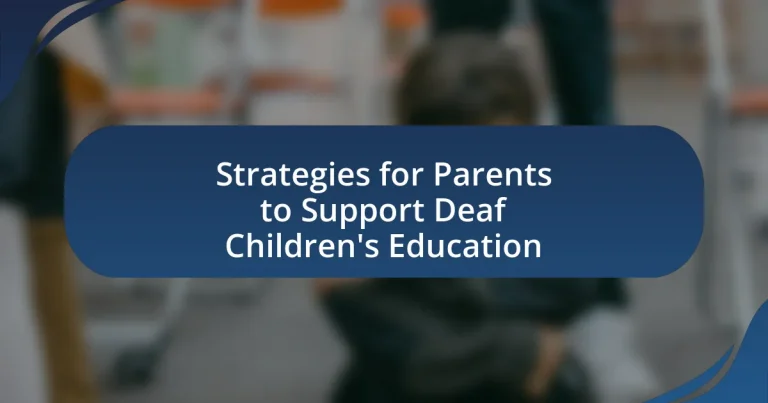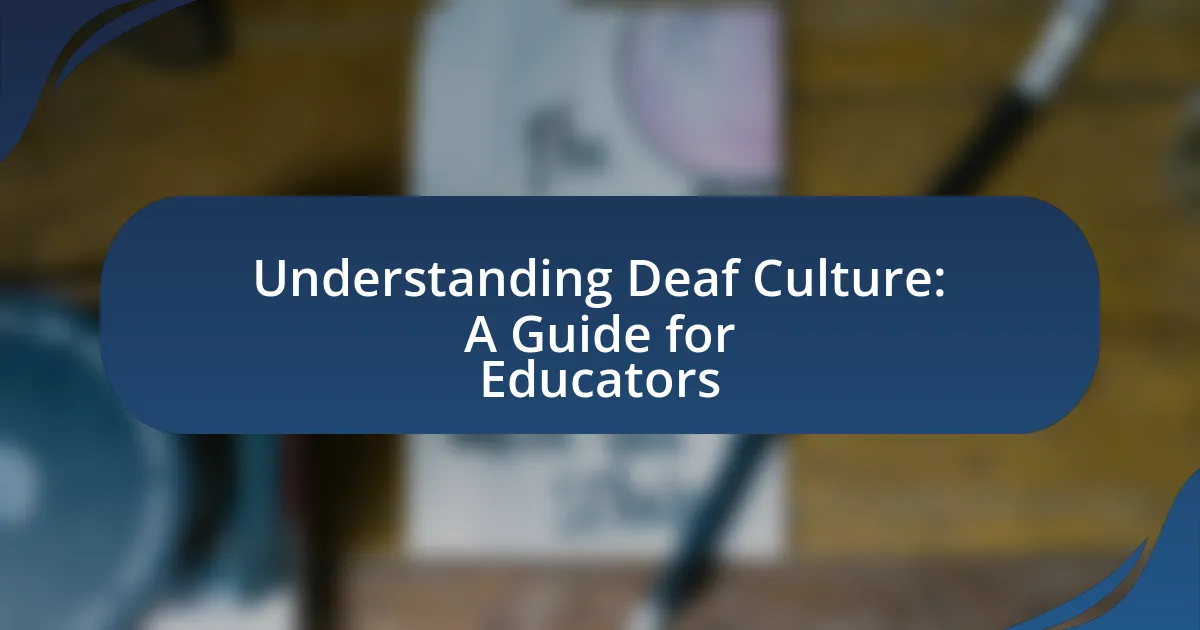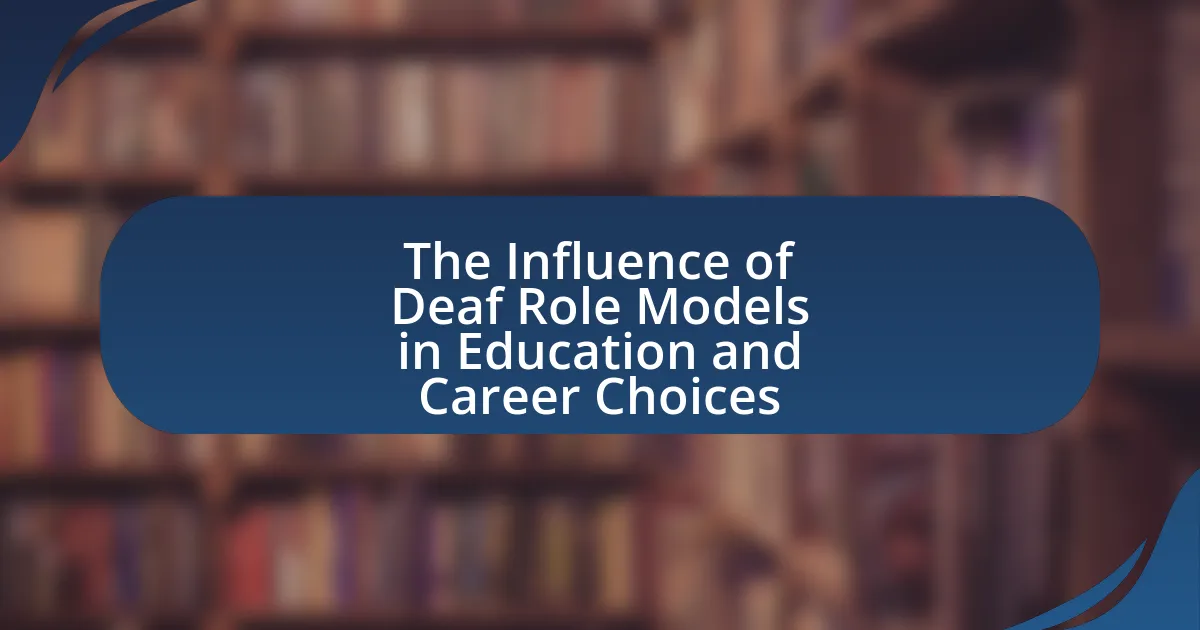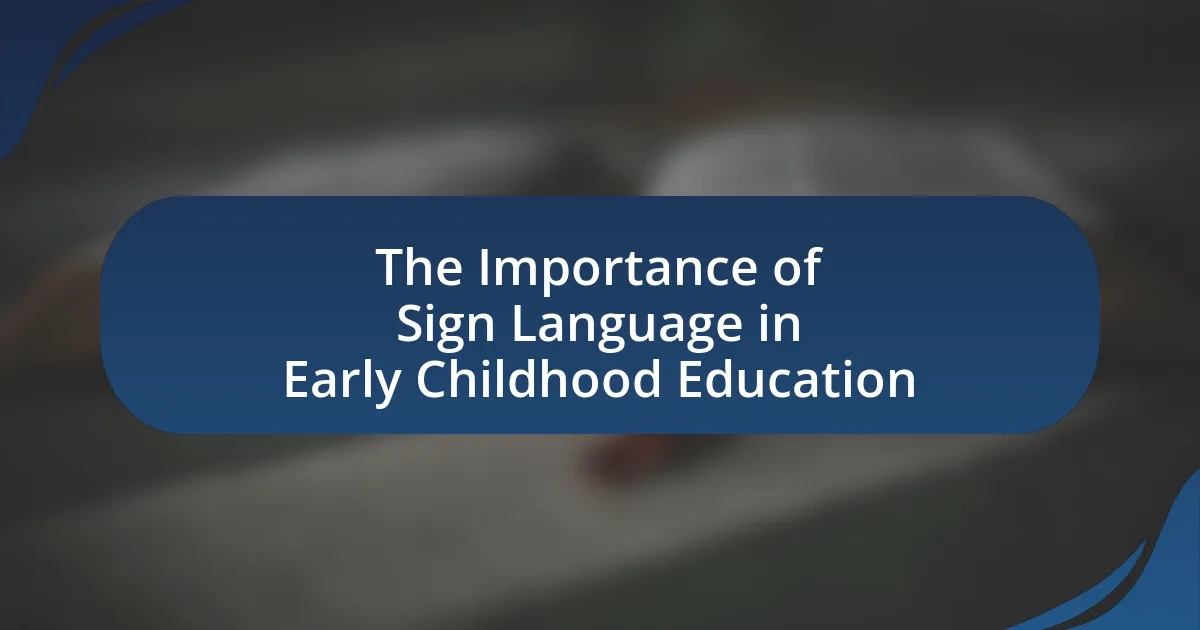The article focuses on effective strategies for parents to support the education of deaf children. It emphasizes the importance of fostering a strong communication environment, utilizing appropriate educational resources, and advocating for their child’s needs. Key topics include creating a supportive learning environment, enhancing communication skills through sign language, accessing specialized educational materials, and collaborating with educators. Additionally, the article discusses the significance of community resources, social skill development, and emotional well-being, providing practical tips for parents to enhance their child’s educational experience and overall development.
What are Effective Strategies for Parents to Support Deaf Children’s Education?
Effective strategies for parents to support deaf children’s education include fostering a strong communication environment, utilizing appropriate educational resources, and advocating for their child’s needs. Parents should prioritize learning sign language or other communication methods to enhance interaction and understanding. Research indicates that early exposure to sign language significantly improves language development and academic success for deaf children. Additionally, parents can seek out specialized educational programs and resources tailored to deaf learners, such as schools with trained staff and accessible materials. Advocacy is crucial; parents must engage with educators and school systems to ensure their child receives necessary accommodations and support, which has been shown to lead to better educational outcomes.
How can parents create a supportive learning environment for their deaf children?
Parents can create a supportive learning environment for their deaf children by fostering effective communication and providing access to resources tailored to their needs. Establishing clear communication methods, such as sign language or visual aids, enhances understanding and engagement in learning. Research indicates that children who use sign language as their primary mode of communication often perform better academically, as it allows for clearer expression of thoughts and concepts. Additionally, parents should seek out educational resources, such as specialized schools or programs that focus on deaf education, which can provide a structured learning environment and access to trained educators. Creating a routine that includes consistent learning times and a quiet, distraction-free space also contributes to a conducive learning atmosphere.
What specific adaptations can be made at home to enhance learning?
To enhance learning for deaf children at home, parents can implement visual aids, such as charts and diagrams, to support understanding. Research indicates that visual learning strategies significantly improve comprehension in deaf students, as they rely more on visual information than auditory cues. Additionally, creating a distraction-free environment with adequate lighting can facilitate better focus and engagement during learning activities. Studies show that minimizing background noise and ensuring clear visibility of the teacher’s face during instruction can enhance communication and learning outcomes for deaf children.
How can parents encourage communication skills in their deaf children?
Parents can encourage communication skills in their deaf children by using sign language as a primary mode of communication. Research indicates that early exposure to sign language enhances language development and cognitive skills in deaf children, allowing them to express themselves effectively. Additionally, parents should engage in interactive activities such as storytelling, playing games, and using visual aids to reinforce communication. Studies show that children who participate in these activities demonstrate improved vocabulary and social skills. By fostering an environment rich in visual communication and interaction, parents can significantly enhance their deaf children’s communication abilities.
What role do educational resources play in supporting deaf children’s education?
Educational resources are essential in supporting deaf children’s education by providing tailored materials and tools that enhance learning and communication. These resources, such as sign language books, visual aids, and specialized software, facilitate access to information and promote engagement in the classroom. Research indicates that the use of appropriate educational resources significantly improves literacy and language skills among deaf students, as evidenced by a study published in the Journal of Deaf Studies and Deaf Education, which found that students using visual learning tools scored higher in reading comprehension tests compared to those who did not. Thus, educational resources play a critical role in bridging communication gaps and fostering an inclusive learning environment for deaf children.
What types of educational materials are most beneficial for deaf children?
Visual educational materials are most beneficial for deaf children. These materials include sign language resources, visual aids like charts and diagrams, and multimedia tools that incorporate captions and subtitles. Research indicates that deaf children learn more effectively when information is presented visually, as it aligns with their primary mode of communication. For instance, a study published in the Journal of Deaf Studies and Deaf Education found that using visual supports significantly improved comprehension and retention of information among deaf students.
How can parents access and utilize community resources for deaf education?
Parents can access and utilize community resources for deaf education by connecting with local organizations, schools, and support groups that specialize in services for deaf children. These resources often include educational programs, advocacy services, and social activities designed to enhance learning and socialization for deaf students. For example, the National Association of the Deaf provides a directory of local chapters that offer various resources, including workshops and family support. Additionally, parents can reach out to their child’s school for information on available services, such as speech therapy or sign language classes, which are often funded through state and federal programs aimed at supporting deaf education.
Why is collaboration with educators important for deaf children’s success?
Collaboration with educators is crucial for deaf children’s success because it ensures tailored educational strategies that meet their unique communication and learning needs. Educators possess specialized knowledge and skills to implement effective teaching methods, such as visual aids and sign language, which enhance comprehension and engagement for deaf students. Research indicates that when parents and educators work together, children experience improved academic outcomes and social integration, as evidenced by a study published in the Journal of Deaf Studies and Deaf Education, which found that collaborative approaches significantly boost language development and self-esteem in deaf children.
How can parents effectively communicate with teachers about their child’s needs?
Parents can effectively communicate with teachers about their child’s needs by establishing open lines of communication and being proactive in discussions. This involves scheduling regular meetings to discuss the child’s progress, sharing specific observations about the child’s behavior and learning style, and expressing any concerns or questions clearly. Research indicates that consistent communication between parents and teachers leads to better educational outcomes for children, as it fosters a collaborative environment focused on the child’s individual needs. For instance, a study published in the “Journal of Educational Psychology” found that parental involvement significantly enhances student achievement, particularly in special education contexts.
What strategies can parents use to advocate for their child’s educational rights?
Parents can advocate for their child’s educational rights by actively engaging with educators and school administrators to ensure compliance with the Individuals with Disabilities Education Act (IDEA). This federal law mandates that children with disabilities, including deaf children, receive a free appropriate public education tailored to their individual needs. Parents should familiarize themselves with their child’s Individualized Education Program (IEP) and participate in IEP meetings to discuss goals, accommodations, and services that support their child’s learning.
Additionally, parents can connect with advocacy organizations, such as the National Association of the Deaf, which provide resources and support for navigating educational rights. Research indicates that parental involvement significantly improves educational outcomes for children with disabilities, reinforcing the importance of advocacy in securing necessary services and accommodations.
How can parents foster social skills and peer relationships for their deaf children?
Parents can foster social skills and peer relationships for their deaf children by actively facilitating inclusive social interactions and providing opportunities for communication. Engaging in activities such as playdates, group sports, or community events where deaf and hearing children can interact helps build friendships. Research indicates that children who participate in inclusive environments develop better social skills, as they learn to navigate diverse communication styles. Additionally, parents can encourage the use of sign language and other communication methods, which enhances peer connections and understanding. Studies show that deaf children who are proficient in sign language often have stronger social networks, as they can communicate effectively with both deaf and hearing peers.
What activities can help deaf children build friendships with peers?
Deaf children can build friendships with peers through activities such as group sports, arts and crafts, and interactive games that promote teamwork and communication. These activities encourage social interaction and help children develop shared interests, which are essential for forming friendships. For instance, participating in team sports like soccer or basketball fosters collaboration and communication, while arts and crafts allow for creative expression and group participation. Research indicates that inclusive environments where deaf children engage in shared activities with hearing peers enhance social skills and friendship formation, as highlighted in studies by the National Institute on Deafness and Other Communication Disorders.
How can parents address potential social challenges faced by deaf children?
Parents can address potential social challenges faced by deaf children by fostering inclusive environments and encouraging social interactions. Engaging in activities that promote communication skills, such as sign language classes or social groups for deaf children, can enhance their ability to connect with peers. Research indicates that deaf children who participate in social activities with both deaf and hearing peers develop better social skills and self-esteem. Additionally, parents should advocate for their child’s needs in educational settings, ensuring that teachers and classmates are aware of and sensitive to the unique challenges faced by deaf children. This proactive approach can significantly mitigate feelings of isolation and enhance social integration.
What are the best practices for supporting deaf children’s emotional well-being?
To support deaf children’s emotional well-being, parents should prioritize effective communication, foster social connections, and promote self-advocacy. Effective communication involves using sign language or other accessible methods to ensure children can express their feelings and needs. Research indicates that children who can communicate effectively are more likely to develop positive self-esteem and emotional resilience. Fostering social connections with peers, both deaf and hearing, helps children build relationships and reduces feelings of isolation, which is crucial for emotional health. Additionally, teaching self-advocacy skills empowers deaf children to express their needs and seek support, contributing to their overall emotional well-being.
How can parents help their deaf children cope with feelings of isolation?
Parents can help their deaf children cope with feelings of isolation by fostering strong communication and social connections. Engaging in regular conversations using sign language or other communication methods enhances emotional expression and understanding. Additionally, parents can encourage participation in deaf community events, which provide opportunities for social interaction and friendship with peers who share similar experiences. Research indicates that social support significantly reduces feelings of loneliness among deaf children, highlighting the importance of community involvement. By actively facilitating these connections, parents can create a supportive environment that mitigates isolation.
What resources are available for mental health support for deaf children?
Mental health support resources for deaf children include specialized counseling services, educational programs, and community organizations. These resources often provide therapists who are fluent in sign language and trained in the unique challenges faced by deaf children. For example, the National Deaf Children’s Society offers mental health resources tailored for deaf children and their families, ensuring access to appropriate support. Additionally, schools for the deaf often have mental health professionals on staff who understand the specific needs of their students, providing a safe environment for emotional expression and support.
How can parents stay informed about advancements in deaf education?
Parents can stay informed about advancements in deaf education by actively engaging with specialized organizations, attending workshops, and subscribing to relevant publications. Organizations such as the National Association of the Deaf and the American Speech-Language-Hearing Association provide resources and updates on the latest research and practices in deaf education. Additionally, attending workshops and conferences allows parents to connect with educators and experts in the field, gaining insights into new methodologies and technologies. Subscribing to journals and newsletters focused on deaf education ensures that parents receive timely information about advancements and best practices.
What organizations provide valuable information and support for parents of deaf children?
Organizations that provide valuable information and support for parents of deaf children include the National Association of the Deaf (NAD), the American Speech-Language-Hearing Association (ASHA), and the Hands & Voices organization. The NAD advocates for the rights of deaf individuals and offers resources for families, while ASHA provides information on communication strategies and services for deaf children. Hands & Voices focuses on supporting families with deaf or hard-of-hearing children through peer support and resources tailored to individual needs. These organizations are recognized for their commitment to enhancing the educational experiences and overall well-being of deaf children and their families.
How can parents participate in workshops or training to enhance their knowledge?
Parents can participate in workshops or training to enhance their knowledge by enrolling in programs specifically designed for them, such as those offered by educational institutions, community organizations, or online platforms. These workshops often focus on communication strategies, educational resources, and advocacy skills tailored for supporting deaf children’s education. For instance, the National Association of the Deaf provides various training sessions that equip parents with essential tools and information. Engaging in these educational opportunities allows parents to gain insights from experts and connect with other families facing similar challenges, thereby fostering a supportive community.
What practical tips can parents implement to support their deaf children’s education?
Parents can support their deaf children’s education by fostering a language-rich environment. This includes using sign language consistently at home, which has been shown to enhance communication skills and academic performance in deaf children. Additionally, parents should collaborate with educators to ensure that their child has access to appropriate resources, such as assistive listening devices and tailored educational materials. Research indicates that early intervention programs significantly improve language acquisition and social skills, making it crucial for parents to seek these services as soon as possible. Engaging in regular communication with teachers and participating in school activities can further reinforce the child’s learning experience.





